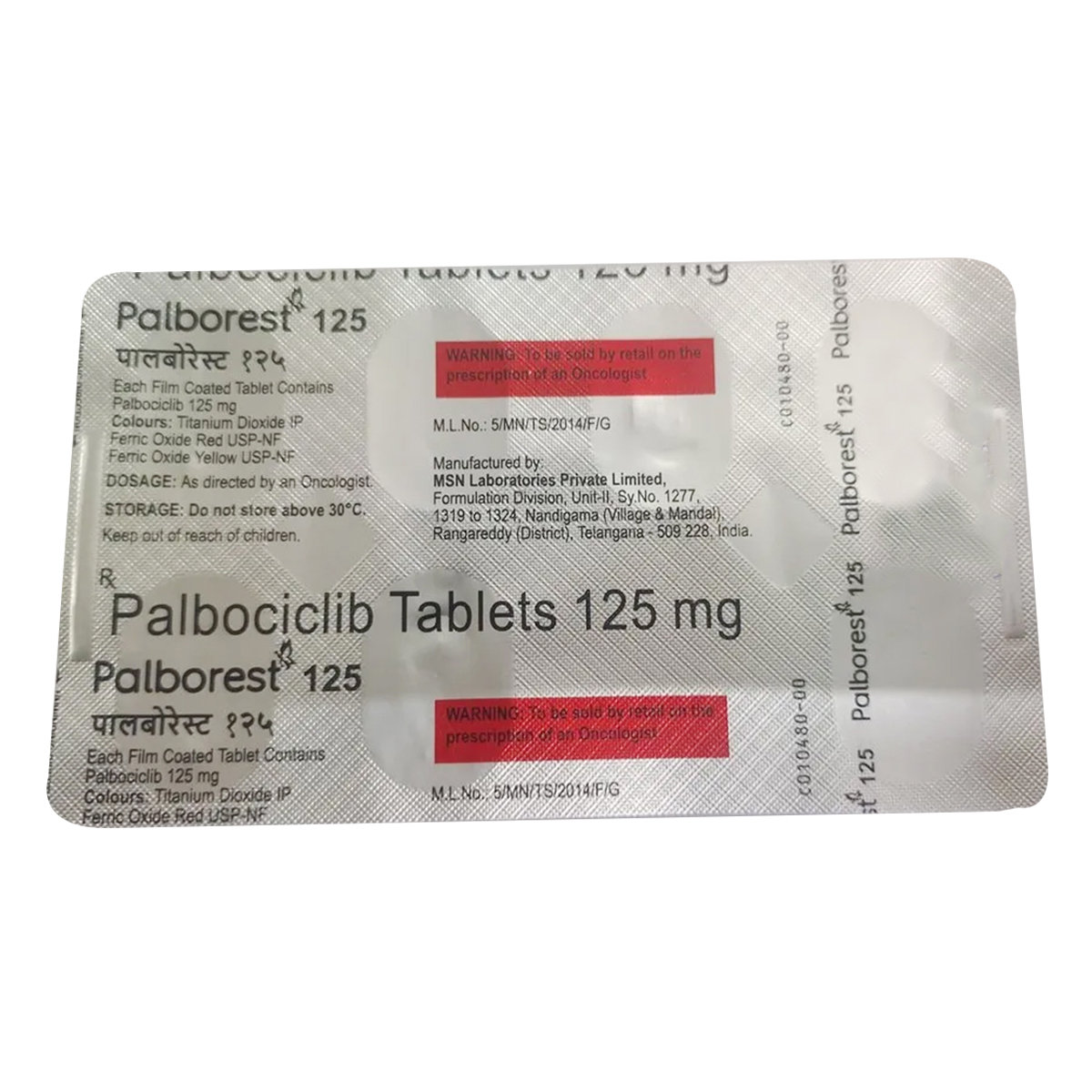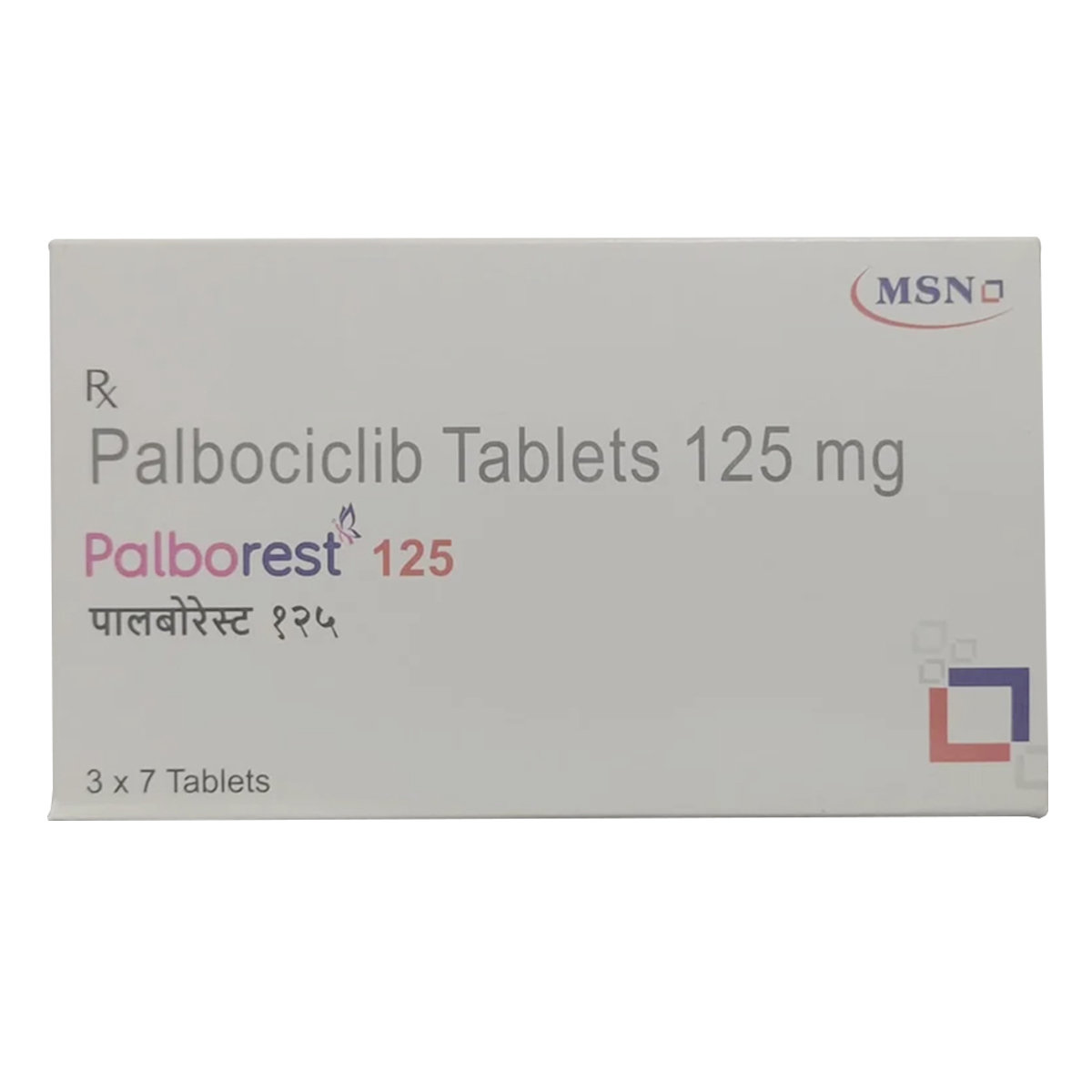Palborest 125 Tablet



MRP ₹1979.5
(Inclusive of all Taxes)
₹296.9 Cashback (15%)
know your delivery time
Provide Delivery Location
Composition :
Manufacturer/Marketer :
Consume Type :
Expires on or after :
Return Policy :

Secure Payment

Trusted by 8 Crore Indians

Genuine Products
Therapeutic Class
Country of origin
Manufacturer/Marketer address
Disclaimer
Alcohol
Safe if prescribed
It is not recommended to use alcohol with Palborest 125 Tablet. Please consult your doctor if you have any concerns.
Pregnancy
Consult your doctor
Palborest 125 Tablet is not recommended for use in pregnancy. Please consult your doctor if you have any concerns.
Breast Feeding
Consult your doctor
Palborest 125 Tablet is not recommended during breastfeeding. Please consult your doctor in case of any concerns.
Driving
Safe if prescribed
Palborest 125 Tablet may cause tiredness and lethargy, which may affect your ability to drive. Do not drive if you experience any side effects after using Palborest 125 Tablet.
Liver
Consult your doctor
Exercise caution before using Palborest 125 Tablet in case of established liver disease. Please consult your doctor to address any concerns.
Kidney
Consult your doctor
Exercise caution before using Palborest 125 Tablet in case of established kidney disease. Please consult your doctor to address any concerns.
Children
Safe if prescribed
Palborest 125 Tablet is not recommended for use in children under 18 years of age. Please consult your doctor in case of any concerns.
Product Substitutes
Reference
- https://www.medicines.org.uk/emc/files/pil.4449.pdf
- https://pubchem.ncbi.nlm.nih.gov/compound/Palbociclib
- https://www.cancer.gov/about-cancer/treatment/drugs/palbociclib
- https://www.uhs.nhs.uk/Media/SUHTExtranet/Services/Chemotherapy-SOPs/Breastcancer/Fulvestrant-Palbociclib.pdf
- https://www.northerncanceralliance.nhs.uk/wp-content/uploads/2018/11/Palbociclib-protocol-CRP13-B033-v1.0.pdf
About Palborest 125 Tablet
Palborest 125 Tablet belongs to the group of anti-cancer drugs used to treat certain types of breast cancer. Cancer is the uninhibited and uncontrolled growth of cells in the body. Breast cancer is cancer that forms in the cells of the breast. It can form in the lobules, ducts or tubules of the breast or in the breast tissue itself.
Palborest 125 Tablet contains Palbociclib that works by blocking proteins necessary for cell growth, thereby causing cell death and arresting the uncontrolled production of new cells. Thus, Palborest 125 Tablet is effective in controlling cancer cells from multiplying and is used in the treatment of breast cancer.
Take Palborest 125 Tablet as prescribed. In some cases, Palborest 125 Tablet may cause certain common side effects such as weakness, loss of appetite, infections and dry skin. Most of these side effects do not require medical attention and will resolve gradually over time. However, you are advised to talk to your doctor if these side effects persist or worsen.
It is advisable to inform the doctor if you are allergic to any of its components. Do not take Palborest 125 Tablet if you are pregnant or breastfeeding. Palborest 125 Tablet may cause tiredness, so drive only if you are alert. Palborest 125 Tablet is not recommended for use in children below 18years. Keep your doctor informed about your health condition and medications to rule out any interactions.
Uses of Palborest 125 Tablet
Medicinal Benefits Mweb
Key Benefits
Palborest 125 Tablet is an anti-cancer drug used in the treatment of a particular type of breast cancer that is hormone receptor-positive and human epidermal growth factor receptor-2-negative. Palborest 125 Tablet works by blocking the production of proteins called cyclin-dependent kinase 4 and 6 that are responsible for cell growth and division. By blocking them, Palborest 125 Tablet nips cell growth in the bud and prevents cancer cells from spreading further. Thus, Palborest 125 Tablet helps treat breast cancer.
Directions for Use
Side Effects of Palborest 125 Tablet
- Loss of appetite
- Dry skin
- Weakness
- Infection
- Hair loss
- Fever
- Inflammation of the mouth and lips
Drug Warnings
Do not take St. John's wort or grapefruit/grapefruit juice with Palborest 125 Tablet. It is advisable to inform the doctor if you are allergic to any of its components. Do not take Palborest 125 Tablet if you are pregnant or breastfeeding. Palborest 125 Tablet may cause tiredness, so drive only if you are alert. Palborest 125 Tablet is not recommended for use in children below 18years. If you experience any signs or symptoms of infections, inform your doctor. Keep your doctor informed about your health condition and medications to rule out any interactions. Consult your doctor immediately if you experience symptoms such as dry cough, chest pain, difficulty breathing or shortness of breath as it could be an indication of lung inflammation
Drug-Drug Interactions
Drug-Drug Interactions
Login/Sign Up
Co-administration of Palborest 125 Tablet with Morphine may increase the blood levels and side effects of morphine.
How to manage the interaction:
Taking Morphine with Palborest 125 Tablet can result in an interaction, but it can be taken if a doctor has advised it. However, if you experience any symptoms like trouble breathing, feeling tired, or having a cough, dizziness, drowsiness, difficulty concentrating, impaired judgment, reaction speed, and motor coordination, make sure to contact a doctor immediately. Do not stop using any medications without consulting a doctor.
Taking Cladribine with Palborest 125 Tablet can increase the risk of developing serious infections.
How to manage the interaction:
Taking Cladribine with Palborest 125 Tablet together can possibly result in an interaction, but it can be taken if your doctor has advised it. However, if you experience fever, chills, diarrhea, sore throat, muscle pains, breathing difficulty, blood in your coughing fluid, weight loss, red or irritated skin, body sores, and discomfort or burning sensation when you urinate, consult a doctor. Do not stop using any medications without a doctor's advice.
Coadministration of Ketoconazole and Palborest 125 Tablet may increase the blood level of Palborest 125 Tablet.
How to manage the interaction:
Although taking Ketoconazole and Palborest 125 Tablet together can result in an interaction, it can be taken if a doctor has prescribed it. However, if you experience nausea, vomiting, diarrhea, loss of appetite, mouth sores, hair loss, weakness, pain, numbness, or tingling in the hands and feet, more severely, consult a doctor. Without consulting a doctor, never stop taking any drugs.
When Palborest 125 Tablet is taken with Posaconazole can increase the blood levels of Palborest 125 Tablet.
How to manage the interaction:
Although there is an interaction between posaconazole and Palborest 125 Tablet, it can be taken if your doctor has advised it. However, if you experience nausea, vomiting, diarrhea, less desire to eat, mouth sores, hair loss, weakness, pain, numbness, or tingling in the hands and feet contact a doctor immediately. Do not discontinue any medications without consulting a doctor.
Drug-Food Interactions
Drug-Food Interactions
Login/Sign Up
Drug-Diseases Interactions
Drug-Diseases Interactions
Login/Sign Up
Drug-Drug Interactions Checker List
- RITONAVIR
- NELFINAVIR
- SAQUINAVIR
- LOPINAVIR
- TELAPREVIR
- ITRACONAZOLE
- KETOCONAZOLE
- VORICONAZOLE
- POSACONAZOLE
- CLARITHROMYCIN
- TELITHROMYCIN
- ABATACEPT
- QUINIDINE
- COLCHICINE
- ALFENTANIL
- FENTANYL
- TACROLIMUS
- CYCLOSPORINE
- PIMOZIDE
- ERGOTAMINE
Habit Forming
Special Advise
- Discuss contraception with your doctor while taking Palborest 125 Tablet.
- People on treatment with Palborest 125 Tablet should use additional contraception (barrier method such as condoms). Contraception should be continued 3 weeks post-treatment for women and 14 weeks post-treatment for men.
- You may want to consider sperm storage before starting Palborest 125 Tablet. Seek counsel on the same from a qualified healthcare individual and/or sperm bank.
- Regular complete blood count monitoring is advised.
Diet & Lifestyle Advise
- Meditation and yoga have been proven very effective in helping cancer patients maintain a healthy attitude and body.
- Eat more lean meats, healthy fats, fruits, vegetables and whole-grain foods to give you more energy.
- Stay hydrated by drinking plenty of water as dehydration is often seen in cancers.
- Taking a stroll in the garden, or spending 30 minutes of your time doing some light physical activity can be very useful. However, do not over-exert yourself if you feel too tired.
- Avoid smoking and alcohol consumption.
All Substitutes & Brand Comparisons
RX
Out of StockPalside 125 Tablet 7's
Mesmer Pharmaceuticals
₹7031
(₹1004.43 per unit)
294% COSTLIERRX
Out of StockPalbace 125 mg Tablet 21's
Pfizer Ltd
₹95000
(₹3709.52 per unit)
1357% COSTLIER

Have a query?
Buy best Neoplastic Disorders products by
Intas Pharmaceuticals Ltd
Natco Pharma Ltd
Dr Reddy's Laboratories Ltd
Cipla Ltd
Celon Laboratories Pvt Ltd
Sun Pharmaceutical Industries Ltd
Alkem Laboratories Ltd
United Biotech Pvt Ltd
Zydus Cadila
Zydus Healthcare Ltd
Neon Laboratories Ltd
Glenmark Pharmaceuticals Ltd
Mylan Pharmaceuticals Pvt Ltd
BDR Pharmaceuticals Internationals Pvt Ltd
Emcure Pharmaceuticals Ltd
Adley Formulations
Samarth Life Sciences Pvt Ltd
Hetero Drugs Ltd
Torrent Pharmaceuticals Ltd
Fresenius Kabi India Pvt Ltd
Pfizer Ltd
Admac Lifesciences(Oncology)
Adley Pharmaceuticals Ltd
Novartis India Ltd
Halsted Pharma Pvt Ltd
Getwell Life Sciences India Pvt Ltd
Lupin Ltd
Cadila Healthcare Ltd
Hetero Healthcare Pvt Ltd
GLS Pharma Ltd
Reliance Formulation Pvt Ltd
Abbott India Ltd
Aimcad Biotech Pvt Ltd
Astra Zeneca Pharma India Ltd
Therdose Pharma Pvt Ltd
Axiommax Oncology Pvt Ltd
Biochem Pharmaceutical Industries Ltd
Khandelwal Laboratories Pvt Ltd
Msn Laboratories Pvt Ltd
Aureate Healthcare
Caitlin Oncology
Dabur India Ltd
Zee Laboratories Ltd
Sarabhai Chemicals (India) Pvt Ltd
Wembrace Biopharma Pvt Ltd
Delarc Pharmaceuticals Pvt Ltd
Medaegis Biotek Pvt Ltd
Panacea Biotec Ltd
RPG Life Sciences Ltd
Shilpa Medicare Ltd
Getwell Oncology Pvt Ltd
Ipca Laboratories Ltd
Miracalus Pharma Pvt Ltd
Biocon Ltd
Cadila Pharmaceuticals Ltd
Eli Lilly and Company (India) Pvt Ltd
Ferring Pharmaceuticals Pvt Ltd
Fresenius Kabi Oncology Ltd
Getwell Pharmaceutical Pvt Ltd
Maximal Healthcare Pvt Ltd
Boehringer Ingelheim India Pvt Ltd
Del Trade International Pvt Ltd
Sayre Therapeutics Pvt Ltd
Akumentis Healthcare Ltd
Corona Remedies Pvt Ltd
Eisai Pharmaceuticals India Pvt Ltd
GlaxoSmithKline Pharmaceuticals Ltd
Hilfen Pharmaceuticals Pvt Ltd
Johnson & Johnson Pvt Ltd
Mankind Pharma Pvt Ltd
Merck Ltd
Oncostar Pharma Pvt Ltd
Rhone Poulenc Rorer India Pvt Ltd
Vhb Life Sciences Inc
Zuventus Healthcare Ltd
Admac Pharma Ltd
Adonis Laboratories Pvt Ltd
Alniche Life Sciences Pvt Ltd
BPRL Pvt Ltd
Caitlin Life Care
Dr Care
German Remedies Ltd
Janssen Pharmaceuticals Pvt Ltd
MEDICAMEN BIOTECH LTD
Maxis Healthcare (I) Pvt Ltd
Pharm Products Pvt Ltd
Accord Life Spec Pvt Ltd
Amps Biotech Biotech Pvt Ltd
Aphia Healthcare
Astellas Pharma India Pvt Ltd
Bangalore Pharmaceutical and Research Laboratory Pvt Ltd (BPRL)
Bharat Serums and Vaccines Ltd
Cellgen Biopharma
Cosmic Life Sciences
Daris Biocare
East West Pharma India Pvt Ltd
Hillrock Biotech Pvt Ltd
Lucien Life Sciences
Maneesh Pharmaceuticals Ltd
Medilief Bioscience Pvt Ltd


